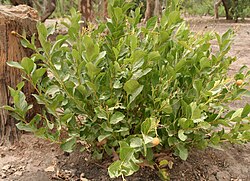| Icacinales Temporal range: [1] | |
|---|---|
 | |
| Icacina oliviformis | |
| Scientific classification | |
| Kingdom: | Plantae |
| Clade: | Tracheophytes |
| Clade: | Angiosperms |
| Clade: | Eudicots |
| Clade: | Asterids |
| Clade: | Lamiids |
| Order: | Icacinales Tiegh. [2] |
| Families | |
Icacinales is an order of flowering plants.
The order did not exist in the 2009 APG III system, and was added in the 2016 APG IV system, including two families, Icacinaceae and Oncothecaceae, which were both unplaced families in APG III. [3] [2]
